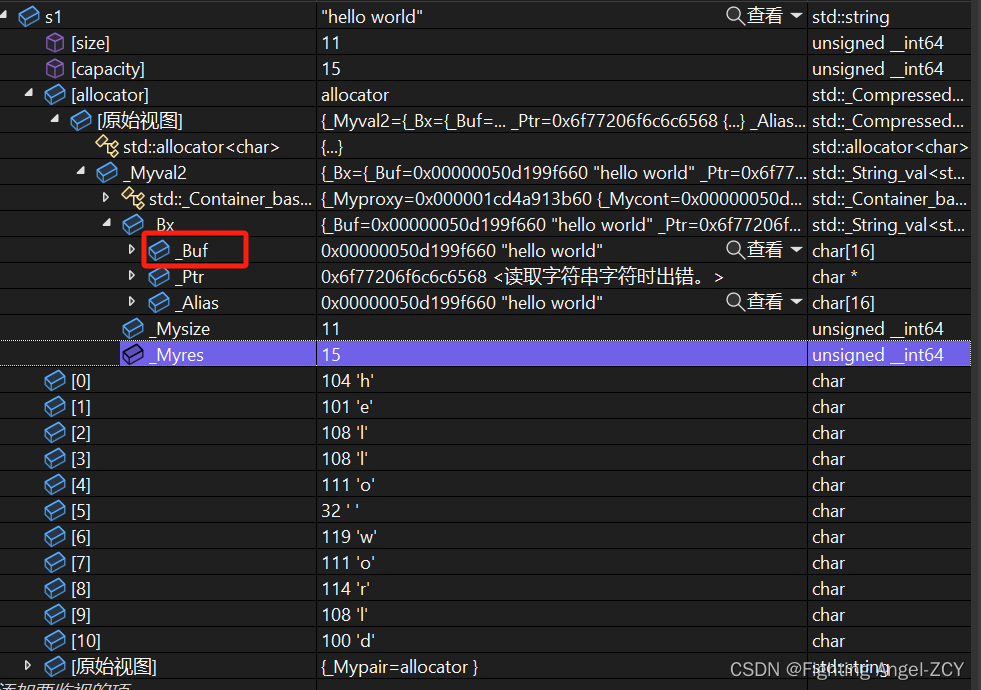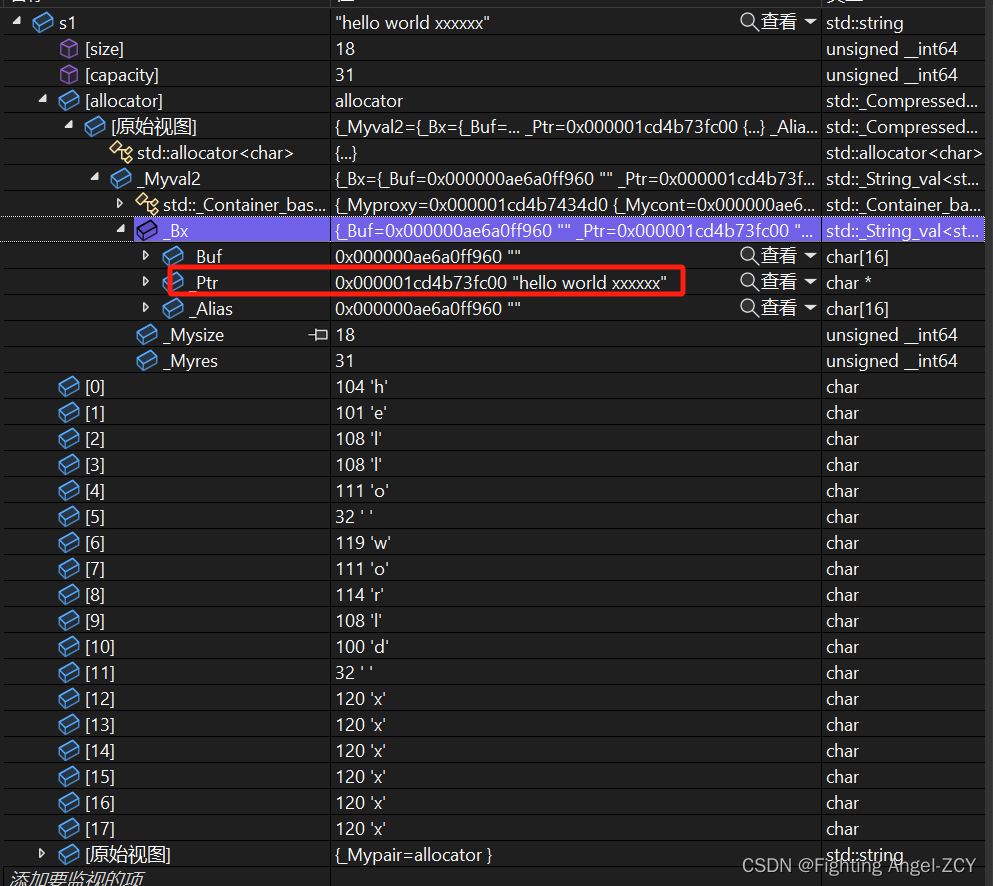hello,各位小伙伴,本篇文章跟大家一起学习《C++:string类》,感谢大家对我上一篇的支持,如有什么问题,还请多多指教 !
如果本篇文章对你有帮助,还请各位点点赞!!!

话不多说,开始进入正题
文章目录
:rocket:什么是string类:rocket:string类对象的构造1.:airplane:无参构造2.:airplane:拷贝构造函数3.:airplane:用C-string来构造string类对象4.:airplane:子字符串构造函数 :rocket:string类对象的访问及遍历操作:airplane:1.string类的迭代器`iterator`:airplane:2.operator[]:airplane:3.begin + end:fire:begin:fire:end :airplane:4.rbegin + rend:fire:rbegin:fire:rend:fire:rbegin + rend结合使用如下: :airplane:5.范围for :rocket:string类对象的容量操作:airplane:1.size:airplane:2.capacity:airplane:3.empty:airplane:4.clear
?什么是string类
C语言中,字符串是以’\0’结尾的一些字符的集合,为了操作方便,C标准库中提供了一些str系列的库函数,但是这些库函数与字符串是分离开的,不太符合OOP的思想,而且底层空间需要用户自己管理,稍不留神可能还会越界访问。
OOP是面向对象编程的意思
所以,C++引入了string类。
字符串是表示字符序列的类标准的字符串类提供了对此类对象的支持,其接口类似于标准字符容器的接口,但添加了专门用于操作单字节字符字符串的设计特性。string类是使用char(即作为它的字符类型,使用它的默认char_traits和分配器类型(关于模板的更多信息,请参阅basic_string)。string类是basic_string模板类的一个实例,它使用char来实例化basic_string模板类,并用char_traits和allocator作为basic_string的默认参数(根于更多的模板信息请参考basic_string)。注意,这个类独立于所使用的编码来处理字节:如果用来处理多字节或变长字符(如UTF-8)的序列,这个类的所有成员(如长度或大小)以及它的迭代器,将仍然按照字节(而不是实际编码的字符)来操作。总结:
string是表示字符串的字符串类该类的接口与常规容器的接口基本相同,再添加了一些专门用来操作string的常规操作。string在底层实际是:basic_string模板类的别名,typedef basic_string<char, char_traits, allocator>string;不能操作多字节或者变长字符的序列。在使用string类时,必须包含#include头文件以及using namespace std;
?string类对象的构造
本文章讲的string类对象的构造只讲比较常用的构造方法以及一些细节。
如下为string类对象的构造:

1.✈️无参构造
string();
#include<string>int main(){string s1;return 0;}此构造为string类的默认构造,构造一个无字符的串(空字符串):
Constructs an empty string, with a length of zero characters.
2.✈️拷贝构造函数
string (const string& str);
#include<string>int main(){string s1("hello world");string s2(s1);return 0;}Constructs a copy of str.
3.✈️用C-string来构造string类对象
string (const char* s);
#include<string>int main(){string s1("hello world");char C_s[] = "hello world";string s2(C_s);return 0;}当然,还可以这么写:
string s3 = "hello world";这里有个隐式类型转换的过程,"hello world"会生成一个string类的临时对象,赋值给s3
string s3 = "hello world";const string& s4 = "hello world";因为临时对象具有常性,所以s4需要用const修饰。
复制s所指向的以null结尾的字符序列(C字符串):
Copies the null-terminated character sequence (C-string) pointed by s.
简单说就是:用一个已有的字符串来初始化。
4.✈️子字符串构造函数
string (const string& str, size_t pos, size_t len = npos);
#include<iostream>#include<string>using namespace std;int main(){string s1("hello world");string s2(s1, 0, 5);cout << s1 << endl;cout << s2 << endl;return 0;}从结果可以猜到,这是string类的部分拷贝初始化:
pos就是拷贝的初始位置(在哪个位置开始拷贝)len就是拷贝的长度npos是len的缺省值,其实是-1,由于size_t是无符号整型,也就是42亿左右,那么不难看出,当我们不穿第三个参数(使用len的缺省值),相当于pos位置后面的字符全部拷贝 ?string类对象的访问及遍历操作
✈️1.string类的迭代器iterator
string 类在 C++ 中提供了多种迭代器类型,包括普通迭代器、常量迭代器、反向迭代器等,可以用来遍历字符串的字符。
普通迭代器 (iterator):
string::iterator 是 string 类的普通迭代器,用于修改字符串内容。例如:std::string str = "Hello";for (std::string::iterator it = str.begin(); it != str.end(); ++it) { *it = std::toupper(*it); // 将字符转换为大写}常量迭代器 (const_iterator):
string::const_iterator 是 string 类的常量迭代器,用于遍历字符串但不能修改其中的字符。例如:std::string str = "Hello";for (std::string::const_iterator it = str.begin(); it != str.end(); ++it) { std::cout << *it; // 打印字符}反向迭代器 (reverse_iterator 和 const_reverse_iterator):
string::reverse_iterator 和 string::const_reverse_iterator 是 string 类的反向迭代器,用于从末尾向前遍历字符串。例如:std::string str = "Hello";for (std::string::reverse_iterator rit = str.rbegin(); rit != str.rend(); ++rit) { std::cout << *rit; // 从后向前打印字符}rit还是++,不是--!!! 这些迭代器类型可以根据需要选择,可以实现对字符串的遍历和修改操作。
✈️2.operator[]
char& operator[] (size_t pos);
const char& operator[] (size_t pos) const;
返回pos位置的字符,const string类对象调用
我们依然可以像字符串数组一样使用[]来访问串内单个字符,如下:
int main(){string s1("hello world");for (int i = 0; i < 12; ++i){cout << s1[i] << " ";}return 0;}同样,我们也可以对串内单个字符进行修改,如下:
int main(){string s1("hello world");for (int i = 0; i < 12; ++i){++s1[i];cout << s1[i] << " ";}return 0;}小细节:operator[]有assert检查是否越界
If pos is equal to the string length and the string is const-qualified, the function returns a reference to a null character (‘\0’)
✈️3.begin + end
?begin
iterator begin();
const_iterator begin() const;
Returns an iterator pointing to the first character of the string.
begin获取第一个字符的迭代器,如下:
c
?end
iterator end();
const_iterator end() const;
Returns an iterator pointing to the past-the-end character of the string.
end获取最后一个字符下一个位置的迭代器如下:
int main(){string s1("hello world");string::iterator lt1 = s1.end()-1;cout << *lt1 << endl;return 0;}可以与begin一起使用遍历串:
string s1("hello world");for (string::iterator i = s1.begin(); i < s1.end(); i++){cout << *i << " ";}也可以用auto修饰i,如下:
string s1("hello world");for (auto i = s1.begin(); i < s1.end(); i++){cout << *i << " ";}✈️4.rbegin + rend
?rbegin
reverse_iterator rbegin();
const_reverse_iterator rbegin() const;
Returns a reverse iterator pointing to the last character of the string (i.e., its reverse beginning).
返回一个反向迭代器,该迭代器指向字符串的最后一个字符(即其反向开头)
?rend
reverse_iterator rend();
const_reverse_iterator rend() const;
Returns a reverse iterator pointing to the theoretical element preceding the first character of the string(which is considered its reverse end).
返回一个反向迭代器,该迭代器指向字符串第一个字符(被视为其反向端)前面的理论元素。
?rbegin + rend结合使用如下:
int main(){string s1("hello world");for (auto i = s1.rbegin(); i < s1.rend(); i++){cout << *i << " ";}return 0;}✈️5.范围for
直接看代码:
int main(){string s1("hello world");for (auto i : s1){cout << i << " ";}return 0;}?string类对象的容量操作
✈️1.size
size_t size() const;
返回字符串的有效长度,如下:
要注意:size是不计算\0的!!!
int main(){string s1("hello world");cout << s1.size() << endl;return 0;}也有一个作为同样功能的操作,length:
int main(){string s1("hello world");cout << s1.length() << endl;return 0;}但是我们更常用size
✈️2.capacity
返回空间总大小,如下:
int main(){string s1("hello world");cout << s1.capacity() << endl;return 0;}不过,有一点需要注意的是:为什么如上代码的输出结果为15呢?
在这段代码中,s1 是一个 string 对象,它使用字符串 “hello world” 进行初始化。在 C++ 的标准库实现中,string 类通常会使用动态内存分配来存储字符串内容。capacity() 方法返回的是当前 string 对象分配的内存空间大小,而不是字符串的实际长度。这是为了避免每次添加字符时都要重新分配内存,提高性能。
对于 “hello world” 这个字符串,实际长度为 11(包括空格),但 string 类一般会预留额外的空间以容纳未来的扩展,以减少频繁的内存分配。因此,当你查询 capacity() 时,得到的值可能会大于字符串的实际长度。在这种情况下,15 表示 string 对象当前分配的内存空间大小,而不是字符串的实际长度。
如图所示:

可以看到hello world存放于_Buf里,但是,当s1超过15个有效字符时,如下:
int main(){string s1("hello world xxxxxx");cout << s1.capacity() << endl;return 0;}
可以看到hello world xxxxxx存放于Ptr里,其实就是存放在堆上
✈️3.empty
bool empty() const;
Returns whether the string is empty (i.e. whether its length is 0)
检测字符串释放为空串,是返回true,否则返回false,如下:
int main(){string s1("hello world");cout << s1.empty() << endl;return 0;}✈️4.clear
void clear();
Erases the contents of the string, which becomes an empty string (with a length of 0 characters).
擦除字符串的内容,该字符串将变为空字符串(长度为0个字符),如下:
int main(){string s1("hello world");cout << s1 << endl;s1.clear();cout << s1 << endl;return 0;}要注意:clear()只是将string中有效字符清空,不改变底层空间大小。
你学会了吗?
好啦,本章对于《C++:string类(第一章)》的学习就先到这里,如果有什么问题,还请指教指教,希望本篇文章能够对你有所帮助,我们下一篇见!!!
如你喜欢,点点赞就是对我的支持,感谢感谢!!!
